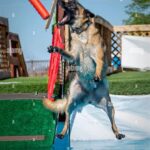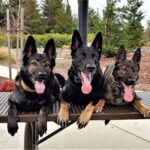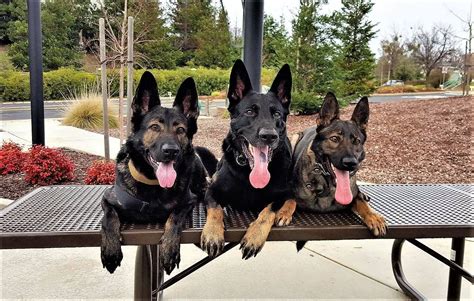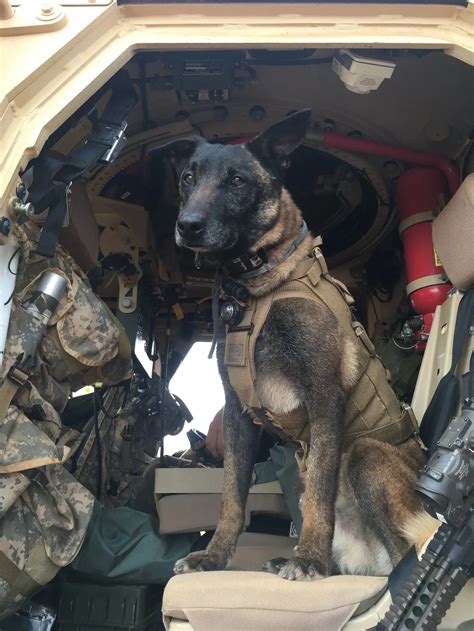
A Belgian Malinois named Poppy asserted her dominance at a Washington state dock, successfully evicting a seal that had taken up residence, in a video that has since gone viral.
A territorial dispute unfolded at a dock in the state of Washington when Poppy, a Belgian Malinois, fearlessly confronted a significantly larger seal, ultimately persuading the marine mammal to relinquish its sunbathing spot. The incident, captured on video and shared widely across social media platforms, showcases the dog’s unwavering determination and has captivated audiences with its unexpected David-versus-Goliath dynamic.
According to the video’s description, Poppy, exhibiting the characteristic confidence and drive of her breed, took it upon herself to challenge the seal’s presence on the dock. The footage shows Poppy barking assertively and maneuvering strategically, never backing down despite the seal’s considerable size advantage. After a tense standoff, the seal eventually retreated into the water, ceding the dock to the victorious canine.
The encounter has sparked a flurry of reactions online, with many praising Poppy’s bravery and commenting on the Malinois’s inherent protective instincts. Others have expressed amusement at the seemingly unlikely showdown and the seal’s ultimate decision to concede. Experts note that while such interactions are not uncommon in areas where wildlife and domesticated animals coexist, they underscore the importance of responsible pet ownership and maintaining a safe distance between pets and wild animals.
“It was pretty funny,” the video’s poster noted, capturing the general sentiment of many viewers who found the interaction both surprising and entertaining.
The incident serves as a reminder of the complex interactions that can occur between domestic animals and wildlife in shared environments, highlighting the need for vigilance and respect for the natural world. While Poppy’s victory may be celebrated by some, it also raises questions about the potential impact of human activity on wildlife habitats and the responsibility of pet owners to ensure the safety and well-being of both their animals and the local ecosystem.
Background on Belgian Malinois
The Belgian Malinois is a breed of dog that originated in Belgium, specifically in the Malines region. They are known for their intelligence, agility, and strong work ethic. Historically, Malinois were bred as herding dogs, but their versatility and trainability have led to their use in various other roles, including police work, search and rescue, and military operations.
Belgian Malinois are medium to large-sized dogs with a short, fawn-colored coat and a black mask. They typically weigh between 40 and 80 pounds and stand 22 to 26 inches tall at the shoulder. Their athletic build and high energy levels require regular exercise and mental stimulation.
Key characteristics of the Belgian Malinois include:
- Intelligence: They are highly intelligent and quick learners, making them easy to train with consistent and positive reinforcement methods.
- Energy: Malinois have a high energy level and require a significant amount of exercise to stay happy and healthy.
- Loyalty: They are loyal and protective of their families, often forming strong bonds with their owners.
- Work Ethic: Bred for herding and other tasks, they have a strong work ethic and thrive when given a job to do.
- Alertness: They are naturally alert and vigilant, making them excellent watchdogs.
The breed’s characteristics make them suitable for various tasks, including:
- Police Work: Their intelligence, trainability, and protective instincts make them ideal for police work, where they are used for tasks such as drug detection, suspect apprehension, and search and rescue.
- Military Operations: Malinois are also used in military operations for similar purposes, often working in challenging environments.
- Search and Rescue: Their keen sense of smell and agility make them valuable in search and rescue operations, helping to locate missing persons.
- Herding: Although less common today, they still retain their herding instincts and can be used to manage livestock.
- Competitive Obedience and Agility: Their intelligence and athleticism make them excel in competitive obedience and agility events.
Potential owners of Belgian Malinois should be aware of the breed’s specific needs and challenges. They require experienced handlers who can provide consistent training, socialization, and exercise. Without proper management, Malinois can become destructive or develop behavioral issues due to their high energy and intelligence.
Seal Behavior and Ecology
Seals are marine mammals belonging to the order Pinnipedia, which also includes sea lions and walruses. They are adapted to life in both aquatic and terrestrial environments, spending much of their time in the water but also coming ashore to rest, breed, and molt. Seals are found in coastal waters around the world, with different species adapted to various climates and habitats.
There are two main groups of seals: true seals (Phocidae) and eared seals (Otariidae). True seals lack external ear flaps and move on land by undulating their bodies, while eared seals have visible ear flaps and can walk on all fours.
Key characteristics of seals include:
- Adaptations to Aquatic Life: Seals have streamlined bodies, flippers for swimming, and a thick layer of blubber for insulation in cold water.
- Diet: Seals are carnivores, feeding primarily on fish, squid, crustaceans, and other marine organisms.
- Social Behavior: Many seal species are social animals, forming colonies or groups, especially during breeding season.
- Breeding: Seals typically breed on land or ice, with females giving birth to one or more pups.
- Molting: Seals undergo an annual molting process, shedding their old fur to grow a new coat.
Seals play important roles in marine ecosystems, both as predators and as prey. They help to regulate populations of fish and other marine organisms, and they serve as a food source for larger predators such as sharks and killer whales.
Common seal behaviors include:
- Hauling Out: Seals come ashore or onto rocks or ice to rest, socialize, and avoid predators.
- Foraging: They spend much of their time foraging for food in the water, using their sensitive whiskers to detect prey.
- Vocalization: Seals communicate with each other using a variety of vocalizations, including barks, growls, and moans.
- Play: Seals are often observed engaging in playful behavior, such as chasing each other in the water or playing with objects.
Seals face various threats, including:
- Habitat Loss: Coastal development, pollution, and climate change can lead to the loss of important seal habitats.
- Pollution: Seals are vulnerable to pollution from oil spills, chemical contaminants, and plastic debris.
- Entanglement: They can become entangled in fishing gear, which can lead to injury or death.
- Hunting: In some areas, seals are hunted for their fur, meat, or oil.
- Climate Change: Changes in sea ice and ocean temperatures can affect seal populations by altering their food sources and breeding habitats.
Understanding seal behavior and ecology is crucial for effective conservation efforts. Protecting their habitats, reducing pollution, and managing fisheries can help to ensure the long-term survival of these fascinating marine mammals.
The Dock as a Shared Space
Docks are structures built along the shoreline of bodies of water, providing access for boats and other vessels. They serve various purposes, including recreational boating, fishing, commercial shipping, and transportation. Docks can be made of wood, concrete, metal, or other materials, and they come in various sizes and designs.
Docks often serve as shared spaces, used by both humans and wildlife. They provide a convenient platform for people to access the water, while also offering a resting spot for marine animals such as seals, sea lions, and birds.
The interaction between humans and wildlife on docks can create both opportunities and challenges. On one hand, docks can provide a unique opportunity for people to observe and appreciate wildlife in their natural environment. On the other hand, they can also lead to conflicts and potential harm to both humans and animals.
Potential issues that can arise on shared docks include:
- Disturbance of Wildlife: Human activity on docks can disturb wildlife, causing them to alter their behavior or abandon their resting spots.
- Aggression: Some animals, such as seals and sea lions, can become aggressive if they feel threatened or disturbed by humans.
- Disease Transmission: Docks can facilitate the transmission of diseases between humans and animals, especially if proper hygiene practices are not followed.
- Property Damage: Wildlife can cause damage to docks and other structures, such as boats and equipment.
- Safety Hazards: Docks can become slippery or hazardous due to the presence of animal waste or debris.
To minimize conflicts and ensure the safety of both humans and wildlife, it is important to follow certain guidelines when using shared docks:
- Maintain a Safe Distance: Keep a safe distance from wildlife, and avoid approaching or interacting with animals.
- Avoid Feeding Wildlife: Do not feed animals, as this can alter their natural behavior and make them dependent on humans.
- Keep Docks Clean: Clean up any waste or debris to prevent the spread of disease and reduce the risk of attracting unwanted animals.
- Supervise Pets: Keep pets on a leash and under control to prevent them from harassing wildlife.
- Respect Wildlife: Observe wildlife from a distance, and avoid making loud noises or sudden movements that could startle them.
By following these guidelines, people can enjoy the benefits of shared docks while also protecting the well-being of wildlife. It is important to remember that docks are part of a larger ecosystem, and our actions can have a significant impact on the environment.
Ethical Considerations and Responsible Pet Ownership
The incident involving Poppy and the seal raises important ethical considerations regarding responsible pet ownership and interactions with wildlife. While Poppy’s actions may be seen as a display of bravery or territoriality, it is crucial to consider the potential harm that such encounters can cause to both domestic animals and wildlife.
Responsible pet ownership involves taking steps to ensure the safety and well-being of pets, as well as minimizing their impact on the environment. This includes:
- Training and Socialization: Providing pets with proper training and socialization can help them to behave appropriately in different situations and reduce the risk of aggressive behavior.
- Leash Control: Keeping pets on a leash when in public areas can prevent them from harassing wildlife or endangering themselves.
- Supervision: Supervising pets closely can help to prevent them from engaging in unwanted behaviors, such as chasing or attacking animals.
- Vaccinations and Health Care: Ensuring that pets are up-to-date on their vaccinations and receive regular veterinary care can help to prevent the spread of disease.
- Responsible Waste Disposal: Cleaning up pet waste can help to reduce the risk of pollution and disease transmission.
Interacting with wildlife requires a different set of considerations. It is important to remember that wildlife is not domesticated and should be treated with respect and caution. Guidelines for interacting with wildlife include:
- Maintaining a Safe Distance: Keeping a safe distance from wildlife can help to prevent disturbance and reduce the risk of aggression.
- Avoiding Feeding: Feeding wildlife can alter their natural behavior and make them dependent on humans.
- Respecting Habitats: Protecting wildlife habitats is essential for ensuring the long-term survival of species.
- Reporting Disturbances: Reporting any instances of wildlife disturbance or harassment can help to ensure that appropriate action is taken.
- Educating Others: Sharing information about responsible pet ownership and wildlife interactions can help to promote a culture of respect and conservation.
In the case of Poppy and the seal, it is important to consider whether Poppy’s actions were appropriate and whether her owner took adequate steps to prevent the encounter. While Poppy’s behavior may have been natural for her breed, it is the responsibility of the owner to manage her behavior and ensure that she does not pose a threat to wildlife.
The incident serves as a reminder that responsible pet ownership and ethical wildlife interactions are essential for maintaining a healthy and balanced ecosystem. By taking steps to protect both domestic animals and wildlife, we can help to ensure that future generations can enjoy the benefits of a diverse and thriving environment.
Expert Opinions and Perspectives
Veterinarians, animal behaviorists, and wildlife experts offer valuable perspectives on incidents like the Malinois-seal encounter. Their insights can help to understand the underlying motivations of the animals involved and provide guidance on how to prevent similar situations in the future.
A veterinarian might focus on the potential health risks to both the dog and the seal. They could emphasize the importance of vaccinations for dogs to prevent the spread of diseases to wildlife. They might also discuss the potential for injuries to either animal during such encounters.
An animal behaviorist could analyze Poppy’s behavior in terms of her breed characteristics and training. They might explain that Malinois are naturally protective and territorial, and that Poppy’s actions were likely driven by her instinct to defend her perceived territory. They could also discuss the importance of proper training and socialization to help dogs manage their instincts and behave appropriately in different situations.
A wildlife expert could offer insights into the seal’s behavior and the potential impact of human activity on its habitat. They might explain that seals often haul out on docks to rest and bask in the sun, and that they may become aggressive if they feel threatened or disturbed. They could also discuss the importance of protecting seal habitats and minimizing human disturbance to ensure the long-term survival of seal populations.
Experts might also comment on the broader implications of such incidents, such as the need for responsible pet ownership and the importance of respecting wildlife. They could emphasize the role of education in promoting a culture of conservation and helping people to understand the complex interactions between humans, domestic animals, and wildlife.
Legal and Regulatory Considerations
Interactions between domestic animals and wildlife can sometimes have legal and regulatory implications, depending on the specific circumstances and location. Laws and regulations related to wildlife protection vary from state to state and can be complex.
In many areas, it is illegal to harass, harm, or kill wildlife, including marine mammals such as seals. These laws are designed to protect wildlife populations and prevent their decline. Violations of these laws can result in fines, imprisonment, or other penalties.
Pet owners may also be held liable for the actions of their pets, particularly if their pets cause harm to wildlife. This could include fines, legal fees, or other damages.
Local ordinances may also regulate the behavior of pets in public areas, such as parks and beaches. These ordinances may require pets to be kept on a leash or under control at all times, and they may prohibit pets from entering certain areas where wildlife is present.
In the case of the Malinois-seal encounter, it is unlikely that any laws were broken, as the incident appeared to be a brief and non-harmful interaction. However, it is important for pet owners to be aware of the laws and regulations in their area and to take steps to ensure that their pets do not violate them.
The Viral Video Phenomenon
The video of Poppy evicting the seal quickly went viral, attracting millions of views and sparking widespread discussion on social media. The reasons for the video’s popularity are multifaceted, reflecting the appeal of animal interactions, the surprise of the outcome, and the accessibility of online content.
Viral videos often capture unexpected or unusual events that resonate with viewers. In this case, the sight of a relatively small dog confronting a much larger seal was both surprising and amusing. The video also tapped into the popular theme of “David versus Goliath,” with viewers rooting for the underdog (or under-dog) to succeed.
Social media platforms play a crucial role in the spread of viral videos. Platforms like YouTube, Facebook, Twitter, and TikTok allow users to easily share videos with their friends and followers, creating a snowball effect that can quickly reach a global audience.
The video’s virality also reflects the growing interest in animal-related content. Videos featuring animals often generate high levels of engagement, as people are drawn to their cuteness, humor, or unique behaviors.
The impact of viral videos can be significant. They can raise awareness of important issues, such as wildlife conservation or responsible pet ownership. They can also generate revenue for content creators and businesses. However, viral videos can also be used to spread misinformation or promote harmful behaviors.
Long-Term Implications and Future Interactions
While the immediate impact of the Malinois-seal encounter may be limited, it raises questions about the long-term implications of human-wildlife interactions and the potential for future conflicts. As human populations continue to grow and encroach on wildlife habitats, encounters between domestic animals and wildlife are likely to become more frequent.
It is important to develop strategies for managing these interactions in a way that minimizes harm to both humans and animals. This could include:
- Education: Educating pet owners about responsible pet ownership and the importance of respecting wildlife.
- Habitat Protection: Protecting wildlife habitats and minimizing human disturbance in these areas.
- Regulations: Implementing regulations to control pet behavior in areas where wildlife is present.
- Monitoring: Monitoring wildlife populations and their interactions with humans and domestic animals.
- Conflict Resolution: Developing strategies for resolving conflicts between humans, domestic animals, and wildlife.
By taking these steps, we can help to ensure that future interactions between humans, domestic animals, and wildlife are safe and sustainable.
FAQ
-
What breed is Poppy, the dog in the video? Poppy is a Belgian Malinois, known for their intelligence, agility, and protective nature.
-
Where did this incident between Poppy and the seal occur? The incident took place on a dock in Washington state.
-
What was the seal doing on the dock before Poppy arrived? The seal was reportedly sunbathing on the dock.
-
Are Belgian Malinois typically aggressive dogs? Belgian Malinois are not inherently aggressive, but they are protective and require consistent training and socialization due to their high energy and strong herding instincts.
-
What should you do if you encounter a seal while walking your dog near a body of water? Keep your dog on a leash and maintain a safe distance from the seal. Avoid approaching or disturbing the animal, and report any signs of distress or injury to local wildlife authorities.
-
Why did the seal leave the dock? The seal likely left the dock due to Poppy’s persistent barking and assertive behavior, feeling threatened and choosing to retreat into the water to avoid further confrontation.
-
Are seals dangerous to dogs? Seals can be dangerous to dogs, especially if they feel threatened. They may bite or use their weight to defend themselves. It’s best to keep a safe distance.
-
What are some of the key characteristics of a Belgian Malinois? Key characteristics include high intelligence, high energy, loyalty, a strong work ethic, and alertness.
-
What are some threats that seals face in their natural environment? Threats include habitat loss, pollution, entanglement in fishing gear, hunting, and climate change.
-
What should people do to protect both domestic animals and wildlife in shared spaces? Maintain a safe distance, avoid feeding wildlife, keep docks clean, supervise pets, and respect wildlife.









